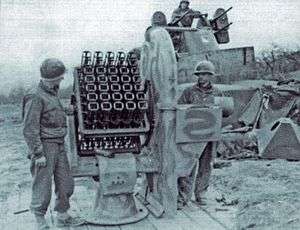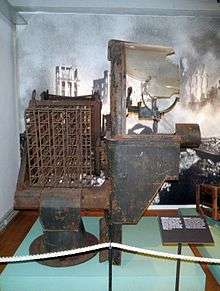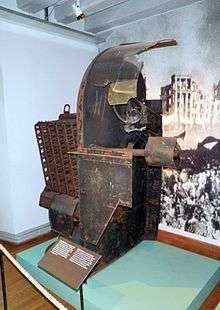Henschel Hs 297
| 7.3 cm Föhn-Gerät | |
|---|---|
 A Föhn-Gerät rocket projector captured by US troops clearly shows the origin of its occasionally used nickname of "Beercrate flak" | |
| Type | Anti-aircraft rocket |
| Place of origin | Nazi Germany |
| Service history | |
| In service | 1943-1945 |
| Used by | Nazi Germany |
| Wars | World War II |
| Production history | |
| Designer | Henschel |
| Manufacturer | Henschel |
| Produced | 1943-1945 |
| Specifications | |
| Barrel length | .78 m (2 ft 7 in) |
| Width | .58 m (1 ft 11 in) |
| Height | .81 m (2 ft 8 in) |
| Crew | 1[1] |
|
| |
| Shell | 28 cm (11 in) |
| Shell weight | 2.74 kg (6 lb 1 oz) |
| Caliber | 72.9 mm (2.87 in) |
| Barrels | 35 |
| Elevation | -10° to +90° |
| Traverse | 360° |
| Maximum firing range | 1.2 km (0.75 mi)[1] |
| Filling | TNT |
| Filling weight | .28 kg (9.9 oz)[1] |


The Henschel Hs 297 Föhn or 7.3 cm Raketen Sprenggranate was a small German surface-to-air rocket of the Second World War. The associated multiple rocket launcher was known as the 7.3 cm Föhn-Gerät.
In principle it was similar to the Fliegerfaust, the main difference being that the Hs 297 was not designed as a shoulder-mounted weapon. In both systems, several small-caliber weapons acting as unguided rockets were to be used against low-flying aircraft
The rockets had a caliber of 7.29 cm (2.87 in), a length of 28 cm (11 in) and a weight of 2.7 kg (5 lb 15 oz). The launch took place from simply-designed racks that could hold 35 rockets (5 × 7) and from which several rockets were fired simultaneously. Also launches of individual rockets were possible. The range was 1.2 km (0.75 mi). Aiming was achieved by direct sight through a semi-circular visor.
For mass deployment in the Volkssturm the device was officially termed the Volk-Fla-R-Werfer - an abbreviation of Volkssturm-Flugabwehr-Raketenwerfer ("Volkssturm anti-aircraft rocket launcher"). By February 1945 50 units were delivered, which were provided to troops for testing. Twenty-four of the launcher racks were assigned to the 3./FlakLehruVersAbt 900 (o) ("3rd Anti-Aircraft Training and Testing Division") in the Remagen area and were used for the first time on 2 March 1945 against Allied fighter-bombers. A few days later, after American forces captured the Ludendorff Bridge at Remagen, some of the launchers (classified as secret) fell intact into the hands of the Americans.
Most of the produced examples of the Bachem Ba 349 Natter ("Viper") manned vertical take-off rocket interceptor were armed with a battery of 24 Föhn missiles in its nose-cone. So far as is known, the Ba 349 was never used in combat, though the rocket weapon system was extensively ground-tested.
See also
- Unrotated projectile - A British anti-aircraft rocket system.
- Z Battery - A British anti-aircraft rocket system.
References
- Bruene, Lothar, and Weiler, Jacob, Remagen in March 1945 - A documentary on the final phase of the World War II, Peace Museum Bridge at Remagen e. V. (ed.), Remagen 1993 ISBN 3-9803385-9-2.